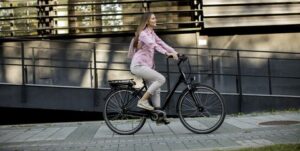THE ELECTRIC BIKE REVOLUTION IN AUSTRALIA: A SUSTAINABLE SHIFT IN URBAN MOBILITY

Electric bikes, or e-bikes, are rapidly transforming the transportation landscape in Australia. As cities grapple with congestion, pollution, and the need for sustainable alternatives, e-bikes offer a compelling solution that combines efficiency, affordability, and environmental consciousness.
THE RISE OF E-BIKES IN AUSTRALIA
The Australian e-bike market has witnessed significant growth in recent years. In 2024, the market was valued at USD 739.2 million and is projected to reach USD 1,336.3 million by 2033, reflecting a compound annual growth rate (CAGR) of 6.10%. This surge is attributed to increasing environmental awareness, urban mobility needs, and government support for sustainable transport.

BENEFITS OF ELECTRIC BIKES
E-bikes offer numerous advantages that make them an attractive option for commuters and recreational users alike:
- Eco-Friendly Transportation: E-bikes produce zero emissions during operation, contributing to reduced air pollution and a smaller carbon footprint.
- Cost-Effective: Compared to cars, e-bikes have lower operating costs, including maintenance and fuel (electricity) expenses.
- Health Benefits: While providing motor assistance, e-bikes still require pedalling, promoting physical activity and cardiovascular health.
- Time Efficiency: E-bikes can navigate through traffic more easily and often have access to bike lanes, reducing commute times.
- Accessibility: E-bikes make cycling more accessible to people of varying fitness levels and ages, encouraging broader adoption.
UNDERSTANDING E-BIKE REGULATIONS IN AUSTRALIA
Regulations for e-bikes in Australia vary by state but generally adhere to the following standards:
- Motor Power: The electric motor should not exceed 250 watts of continuous power.
- Speed Limit: The motor assistance must cut off when the bike reaches 25 km/h.
- Pedal Assist: The motor should only assist while the rider is pedaling; throttle-only e-bikes are subject to different regulations.
For a detailed breakdown of e-bike laws by state, refer to this comprehensive guide: E-Bike Laws in Australia.
SAFETY CONSIDERATIONS AND INCIDENTS
While e-bikes offer numerous benefits, safety concerns have emerged, particularly regarding speed modifications and battery-related incidents. A recent investigation in Sydney revealed that 86% of e-bike riders exceeded the legal speed limit of 25 km/h, with some reaching up to 36 km/h. Additionally, the rise in lithium-ion battery fires has prompted stricter regulations, including fines up to $825,000 for non-compliant devices in New South Wales.
THE FUTURE OF E-BIKES IN AUSTRALIA
The trajectory of e-bikes in Australia points toward continued growth and integration into the urban transport ecosystem. Government initiatives, such as infrastructure development and regulatory frameworks, aim to support this transition. Moreover, the increasing adoption of e-bikes aligns with global efforts to combat climate change and promote sustainable living.
ELECTRIC BIKE ADOPTION ACROSS AUSTRALIA – STATE AND CITY BREAKDOWN
Electric bikes are becoming a familiar sight in nearly every Australian city. But adoption is far from uniform. From Sydney’s harbourside trails to Melbourne’s inner-north cycling boom, usage patterns differ widely based on infrastructure, geography, climate and commuter culture. This section explores how e-bikes are shaping urban mobility in each major state and their respective metro suburbs.
NEW SOUTH WALES (NSW)
New South Wales, particularly Greater Sydney, has seen an unprecedented uptick in electric bike use, with commuters turning to e-bikes to avoid rising tolls, train delays, and fuel costs. According to Transport for NSW, cycling rates have increased across the city post-COVID, with electric models accounting for a growing share of rides.
Sydney Metro Hotspots:
- Manly & Northern Beaches: E-bike use is thriving here, supported by scenic bike lanes and active local cycling groups.
- Inner West: Areas like Newtown and Marrickville report higher daily ridership thanks to flat terrain and good bike infrastructure.
- Eastern Suburbs: Bondi and Coogee are witnessing commuter and leisure riders opting for pedal-assist bikes over cars.
VICTORIA
Melbourne, known for its cycle-friendly initiatives, has one of the most developed networks of off-road bike paths in Australia. According to VicRoads, electric bikes are now a major player in commuting patterns across the city.
Melbourne Metro Hotspots:
- Brunswick & Fitzroy: The epicentre of Melbourne’s cycling culture, these suburbs are packed with bike lanes and e-bike stores.
- Southbank & Docklands: High-density living and short commute distances make e-bikes an attractive option for city workers.
- Footscray: Growing popularity among multicultural communities seeking affordable, flexible transport.
QUEENSLAND
Brisbane and the Gold Coast have benefited from year-round cycling weather. A study by the Queensland Department of Transport and Main Roads highlighted that 68% of e-bike riders in Brisbane use them to replace car trips entirely.
Brisbane Metro Hotspots:
- West End: Popular for short urban rides, especially among young professionals and students.
- New Farm: Ideal terrain and lifestyle culture support high e-bike usage.
- South Brisbane: Key corridor for mixed-mode commuters (train + bike combos).
Gold Coast Highlights:
The flat coastal strip from Southport to Coolangatta is perfect for electric bikes, especially with expanded cycleways under the City of Gold Coast‘s Active Travel initiative.
WESTERN AUSTRALIA
Perth has embraced electric bikes as a viable commuter tool, especially in areas where public transport gaps exist. The WA Department of Transport has funded new infrastructure to accommodate e-bike growth.
Perth Metro Hotspots:
- Fremantle: With eco-conscious residents and compact city planning, e-bikes are becoming the transport of choice.
- Leederville & Subiaco: High-density housing and good path access foster heavy use of pedal-assist bikes.
- East Perth: Office workers use e-bikes for cross-city trips, avoiding car congestion and parking fees.
SOUTH AUSTRALIA
Adelaide is positioning itself as a leader in sustainable transport. According to the SA Department for Infrastructure and Transport, cycling traffic has increased significantly in the CBD, largely driven by electric models.
Adelaide Metro Hotspots:
- North Adelaide: Frequent e-bike use among professionals commuting to government and hospital precincts.
- Glenelg: Beachside suburb with a scenic, flat coastal path – ideal for leisure rides and tourism-based usage.
- Norwood & Kensington: Increasing e-bike presence due to lifestyle appeal and short inner-city distances.
TASMANIA
Though Tasmania has a smaller population, Hobart is experiencing steady growth in electric bike use, aided by environmental incentives and bike-friendly planning.
Hobart Metro Highlights:
- Sandy Bay: Popular with university students and retirees using e-bikes for short daily errands.
- Battery Point: Steep hills in the area make pedal-assist bikes particularly useful.
AUSTRALIAN CAPITAL TERRITORY (ACT)
Canberra has invested in over 100 km of shared paths. According to Transport Canberra, local residents are using e-bikes as part of a broader multi-modal commuting shift, supported by government-led e-bike hire trials.
Canberra Metro Hotspots:
- Braddon & Civic: High daily use among professionals and government workers.
- Belconnen: Great path networks and parking encourage high uptake.
NORTHERN TERRITORY
Darwin’s flat landscape and short distances make it ideal for e-bike commuting, although heat management remains a consideration. There are increasing reports of young commuters and hospitality workers turning to e-bikes as primary transport.
Darwin Metro Areas:
- Parap & Stuart Park: Proximity to the city and bike lanes support rising e-bike use.
- Nightcliff: Scenic coastline rides draw both locals and tourists on e-bikes.
STATE-BY-STATE SNAPSHOT: ELECTRIC BIKE TRENDS (HTML TABLE)
| State | Metro Areas | Usage Trend | Key Factor |
|---|---|---|---|
| NSW | Sydney, Manly, Inner West | High & accelerating | Public transport substitution |
| VIC | Melbourne, Brunswick, Southbank | Strong & sustained | Cycling infrastructure |
| QLD | Brisbane, Gold Coast | Fast growth | All-weather riding |
| WA | Perth, Fremantle | Emerging | New infrastructure |
| SA | Adelaide, Glenelg | Moderate | Sustainability push |
| TAS | Hobart | Growing steadily | Compact city layout |
| ACT | Canberra | Consistent | Government programs |
| NT | Darwin | Early adoption | Flat terrain |
CONCLUSION
Electric bikes represent a significant shift in how Australians approach transportation. By offering an eco-friendly, cost-effective, and health-promoting alternative to traditional vehicles, e-bikes are poised to play a pivotal role in shaping the future of urban mobility in Australia.
For more information on sustainable transportation initiatives and e-bike regulations, visit the following resources:
